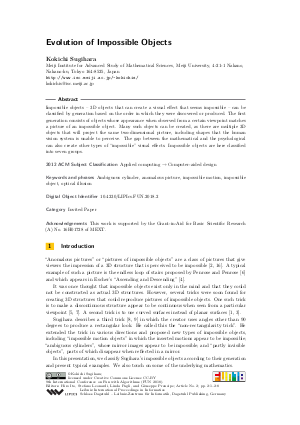Evolution of Impossible Objects (Invited Paper)
Author Kokichi Sugihara
-
Part of:
Volume:
9th International Conference on Fun with Algorithms (FUN 2018)
Part of: Series: Leibniz International Proceedings in Informatics (LIPIcs)
Part of: Conference: International Conference on Fun with Algorithms (FUN) - License:
 Creative Commons Attribution 3.0 Unported license
Creative Commons Attribution 3.0 Unported license
- Publication Date: 2018-06-04
File

PDF
LIPIcs.FUN.2018.2.pdf
- Filesize: 15.33 MB
- 8 pages
Document Identifiers
Subject Classification
ACM Subject Classification
- Applied computing → Computer-aided design
Keywords
- Ambiguous cylinder
- anomalous picture
- impossible motion
- impossible object
- optical illusion
Metrics
- Access Statistics
-
Total Accesses (updated on a weekly basis)
0Document
0Metadata
Abstract
Impossible objects - 3D objects that can create a visual effect that seems impossible - can be classified by generation based on the order in which they were discovered or produced. The first generation consists of objects whose appearance when observed from a certain viewpoint matches a picture of an impossible object. Many such objects can be created, as there are multiple 3D objects that will project the same two-dimensional picture, including shapes that the human vision system is unable to perceive. The gap between the mathematical and the psychological can also create other types of "impossible" visual effects. Impossible objects are here classified into seven groups.
Cite As Get BibTex
Kokichi Sugihara. Evolution of Impossible Objects (Invited Paper). In 9th International Conference on Fun with Algorithms (FUN 2018). Leibniz International Proceedings in Informatics (LIPIcs), Volume 100, pp. 2:1-2:8, Schloss Dagstuhl – Leibniz-Zentrum für Informatik (2018)
https://doi.org/10.4230/LIPIcs.FUN.2018.2
BibTex
@InProceedings{sugihara:LIPIcs.FUN.2018.2,
author = {Sugihara, Kokichi},
title = {{Evolution of Impossible Objects}},
booktitle = {9th International Conference on Fun with Algorithms (FUN 2018)},
pages = {2:1--2:8},
series = {Leibniz International Proceedings in Informatics (LIPIcs)},
ISBN = {978-3-95977-067-5},
ISSN = {1868-8969},
year = {2018},
volume = {100},
editor = {Ito, Hiro and Leonardi, Stefano and Pagli, Linda and Prencipe, Giuseppe},
publisher = {Schloss Dagstuhl -- Leibniz-Zentrum f{\"u}r Informatik},
address = {Dagstuhl, Germany},
URL = {https://drops.dagstuhl.de/entities/document/10.4230/LIPIcs.FUN.2018.2},
URN = {urn:nbn:de:0030-drops-87939},
doi = {10.4230/LIPIcs.FUN.2018.2},
annote = {Keywords: Ambiguous cylinder, anomalous picture, impossible motion, impossible object, optical illusion}
}
Author Details
References
-
G. Elber. Modeling (seemingly) impossible models. Computer and Graphics, 35(3):632-638, 2011.

-
B. Ernst. The Eye Beguiled: Optical Illusion. Benedikt Taschen Verlag GmbH, 1992.

-
B. Ernst. Impossible World. Taschen GmbH, 2006.

-
M. C. Escher. M. C. Escher: The Graphic Work, 25th Edition. Taschen America, 2008.

-
R. L. Gregory. The Intelligent Eye. Weidenfeld and Nicolson, 1970.

-
L. S. Penrose and R. Penrose. Impossible objects: a special type of visual illusion. British Journal of Psychology, 49(1):31-33, 1958.

-
A. I. Seckel. Master of Deception. Sterling Publishing Co., Inc., 2004.

-
Kokichi Sugihara. Machine Interpretation of Line Drawings. The MIT Press, 1996.

-
Kokichi Sugihara. Three-dimensional realization of anomalous pictures: An application of picture interpretation theory to toy design. Pattern Recognition, 30(7):1061-1067, 1997.

-
Kokichi Sugihara. Design of solids for antigravity motion illusion. Computational Geometry: Theory and Applications, 47(6):675-682, 2014.

-
Kokichi Sugihara. Ambiguous cylinders: A new class of impossible objects. Computer Aided Drafting, Design and Manufacturing, 25(3):19-25, 2015.

-
Kokichi Sugihara. Height reversal generated by rotation around a vertical axis. Journal of Mathematical Psychology, 68-69(October-December):7-12, 2015.

-
Kokichi Sugihara. Anomalous mirror symmetry generated by optical illusion. Symmetry, 8(4):2-22, 2016.

-
Kokichi Sugihara. A new type of impossible objects that become partly invisible in a mirror. Japan Journal of Industrial and Applied Mathematics, 33(3):525-535, 2016.

-
Kokichi Sugihara. Topology-disturbing objects: A new class of 3d optical illusion. Journal of Mathematics and the Arts, 12(1):2-18, 2018.

-
J. T. Unruh. Impossible Objects. Sterling Publishing Co., Inc., 2001.

